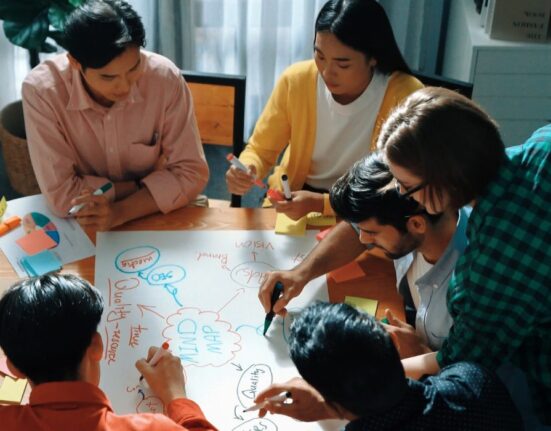Has it ever crossed your mind that the brain is deeply social and bonded in nature? While traditionally regarded as an individual control system for individual thinking and intelligence, the brain is actually a social organ, designed with attachment and bonding in mind. It is very much dependent on relationship, as attested by a wealth of empirical evidence, most particularly Cozolino (2025), a preeminent authority in the field.
Read More: Exploring Human Connection: A Look at Attachment Theory
The Brain’s Fundamental Need for Attachment
Our brains aren’t fixed—they’re rebuilt with each experience: every handshake, conversation, or even uncomfortable silence. The nature of these social encounters significantly influences neural development. Positive encounters create new neural pathways, while negative ones leave lasting, indelible marks. Social interaction is not just a good thing—it is integral to intellectual growth and general welfare.
The “social brain,” however, is not confined to a specific cerebral site but arises from the coordinated activity of many brain areas. Emotions are quickly processed by the amygdala, an integral limbic system structure, whereas the prefrontal cortex (PFC) constructs rational social choices. These areas engage in a dynamic conversation with each other with each interaction, integrating emotional responses with reason (Senland, 2015).
Cozolino’s social synapse theory assumes that relationships do indeed redesign our neural structure. Healthy relationships build emotional maturity, while unhealthy relationships threaten to result in adaptive behaviour (Senland, 2015). An understanding of the social brain is important, as it reveals why normal social environments are not luxuries but predictors of mental well-being and the best brain functions.
The Irreplaceable Role of Social Interaction
Social interaction is not just about being polite to one another; it is the foundation on which humans exist. Lieberman (2013) points out that human social yearning is as inherent as hunger or shelter. Social interaction within the brain is the product of a million years of evolution, with complex neural processes having been refined to improve interaction, bonding, empathy, and cooperation. Mental wellness clearly thrives through social relationships, promoting:
- Improved mood.
- Enhanced cognitive function.
- Increased overall life satisfaction.
Social isolation, on the contrary, has catastrophic effects on both mental and physical health. The structure of the brain itself changes and adapts to meet social experience (Cozolino, 2025). So, minding one’s social relationships is not just fulfilling a general requirement; it does much to make one stronger in resistance to psychological adversity over the course of one’s lifespan.
The Brain’s Social Blueprint: Critical Neural Components
The human brain is a complicated web of areas and networks that enable complicated social behaviours. Social neuroscience investigations show that these behaviours are facilitated by a multifaceted interaction of social cognition, motivation, and decision-making. The medial prefrontal cortex (mPFC), for example, plays a critical role in constructing information about other persons and exhibits increased activity in social interactions, becoming a key element of the ‘social brain’ network (Kim & Sul, 2023).
Meta-analytic analyses have revealed common neural networks that are activated with different kinds of social interactions, which suggests that the same brain mechanisms are activated whether one goes to a social party or a meeting for work (Feng et al., 2021). The default mode network (DMN) and salience network are specifically highlighted to play an important role in social cue interpretation and motivation of relation-based behaviours. The dynamic interactions of the social brain networks not only organise individual interactions but also shape large-scale social functioning and well-being.
Read More: Importance of Social Interaction in Early Childhood Development
1. Social Brain Regions
Brain imaging studies localised a sequence of important brain regions that are intensely activated during social activities:
- A default Mode Network (DMN): Regions such as the medial prefrontal cortex and posterior cingulate cortex make up the DMN, a core function in social cognition for inferring others’ emotions or thoughts (Feng et al., 2021).
- Salience Network: The network involves the anterior insula and anterior cingulate cortex and plays a role in perceiving salient social information and emotional responding, and thus enhancing communication.
- Central Executive Network: Engaging lateral prefrontal areas, this network offers cognitive control to facilitate the management of complicated social circumstances.
- Temporoparietal Junction (TPJ): In facilitating “mentalizing” in interaction and joint action, the TPJ promotes empathising and support of understanding intentions (Oesch, 2024).
- Amygdala and Hypothalamus: These areas play a crucial role in coping with emotion and storing pleasant social experiences.
These interactive networks work synergistically to facilitate a tremendous variety of social behaviour.
The Mirror Neuron System: Mirroring Others’ Experiences
The finding of mirror neurons in the early 1990s, first in macaque monkeys, completely changed our knowledge about social cognition. The special neurons respond with double activation: they fire both when a person acts and when they see another person perform the same action. The mirroring is the basis for learning from imitation, empathy, and understanding others’ goals (Oesch, 2024), the foundation for what is broadly known as “theory of mind.”
Studies indicate that this mirror activity allows for the perception of other people’s emotional states and intentions, and thus social interaction and bonding. Although evidence for mirror neurons is more direct in non-human primates, studies in humans indicate parallel brain activity in the parietal and frontal cortices when observing people (Oesch, 2024). Beyond mimicry, mirror neurons are also thought to be the main mechanism of emotional resonance that allows us to partake in the sensations of others. This not only fosters empathy but also strengthens cooperative actions, the foundation of a united society. More studies will continue to uncover how these systems of neurons all allow for our intricate social behaviour.
Read More: The Role of Theory of Mind in Autism Spectrum Development
1. Empathetic Understanding
Mirror neurons are crucial for recognising the emotional states of others, the very basis of empathy and social connection. These specific neurons fire both when a person performs an action and when they witness the same action. The process of mirroring enables emotional contagion with other individuals, allowing for a deeper understanding of what they could be thinking and experiencing. It’s thought to be the basis for “theory of mind,” enabling an individual to deduce the state of mind of another from their behaviour and facial expressions (Oesch, 2024).
The function of mirror neurons in social interactions is to decode emotional cues, including facial expression and tone of voice, in an effort to enhance empathetic skills. Empathetic skill is required to form social relationships, build trust, and maintain cooperation (Frith & Frith, 2010). The neuroprocesses supporting empathetic responses have been suggested to be necessary to deal with complex social environments. We realise that understanding another person’s emotional state profoundly impacts subsequent interactions (Bonini et al., 2022). These neuronal processes highlight how deeply our emotional experiences connect with others and how essential empathy is in human interactions.
The Medial Prefrontal Cortex: Where Empathy and Morality Entwine
The medial prefrontal cortex (mPFC) is also key to integrating rich social information and determining how people both comprehend and react to others’ emotions. In particular, the mPFC plays a basic function in higher-order cognitive tasks, such as emotional regulation and perspective-taking, both of which are essential to empathy. There is evidence that lesions to certain areas of the mPFC can lead to considerable impairments in moral decision-making and emotional identification. Research suggests that patients with mPFC lesions cannot recognise emotional cues or make proper social choices.
The mPFC is not independent; it works in conjunction with other brain areas responsible for emotion processing, including the amygdala and hippocampus. The synergy supports moral reasoning by correlating emotional with cognitive processing of social environments. For instance, when people face an ethically challenging situation, the mPFC activates to reflect on potential consequences for others, prompting empathetic reactions. The stakes are high: many people with autism spectrum disorder have abnormal function of the mPFC, which can interfere with empathetically connecting or solving moral reasoning dilemmas.
The Role of Oxytocin
Oxytocin, secreted in the hypothalamus, is both a hormone and a neurotransmitter, and serves a significant role in building trust along with social bonding. It boosts feelings of trust as well as generosity among individuals, promoting cognitive as well as affective empathy by socially rendering them more sensitive (Yue, 2023). Researchers have found that administering oxytocin enhances emotional recognition and increases self-reported empathy. Oxytocin also interacts with brain areas related to empathy, like the insula and anterior cingulate cortex, and may minimise egocentric bias and maximise emotional comprehension (Yue, 2023).
In addition, it suppresses amygdala activity—the brain region in charge of processing negative emotions—resulting in a more optimistic state of mind. Its effects reach beyond simple social interaction, shaping behavioural patterns through neurogenesis, especially during pre- and postnatal stages. Enhanced expression of oxytocin receptors indicates that early exposure creates lasting effects on social behaviour (Yue, 2023). Lastly, variations in oxytocin are essential for building trust and forming strong social bonds.
Read More: Mastering Your Emotions: A Guide to Emotional Control
1. Observable changes in Social Relationships
Oxytocin dramatically improves social relations and builds communities by supporting prosocial responses and dampening social anxiety. Oxytocin increases bonding through emotional empathy and mutual trust. It has been discovered to increase mirror neuron activity, which is crucial for social behaviour and emotional sensitivity. Research demonstrates oxytocin increases brain response to positive social interactions and lessens responding to negativity, generating a positive social environment (Yue, 2023).
Apart from its immediate impact on social interaction, oxytocin enhances emotional regulation by reducing unfavourable emotions such as fear and anxiety, reducing social stressors, and enabling interaction with others. In states of fear, oxytocin reduces discomfort, allowing for actual contact (Jones et al., 2017). Its effect on brain regions engaged with rewards indicates that it amplifies the subjective worth of social interactions by enhancing activation with favourable stimuli, further supporting the importance of communal relationships. In brief, oxytocin promotes long-term relationships and a sense of community by enhancing empathy and decreasing social participation barriers.
The Social Brain under Suffering: Isolation Consequences
Extreme social isolation measurably impairs brain function, with neuroscience research showing negative effects on both mental and cognitive functioning. Research shows that severe loneliness correlates with structural changes in key brain regions, such as the prefrontal cortex and amygdala. These changes result in increased emotional dysregulation, thereby increasing vulnerability to depressive and anxiety disorders.
For example, studies have confirmed that people who experience prolonged isolation have a greater amygdala volume, consistent with emotional abnormality (How Social Isolation Affects the Brain | Psychology Today, 2023).
Additionally, neuroimaging results indicate diminished grey and white matter volumes in isolated populations, especially in the prefrontal cortex—a critical area for decision-making and social behaviour. It is this decrease that can be responsible for noted deficits in empathy and moral reasoning in people with severe social deprivation (Bzdok & Dunbar, 2022).
Furthermore, researchers have noted oligodendrocyte modification—cells that produce myelin—under conditions of isolation. This causes defective neuronal communication that can hinder cognitive development (How Social Isolation Affects the Brain | Psychology Today, 2023).
These changes in the neural tissue point to a greater trend: social isolation is associated with heightened stress responses, which are driven by neurotransmitters like glucocorticoids. Increased levels of the stress hormones under isolation situations heighten the feeling of anxiety and worsen depression (Vitale & Smith, 2022), creating a self-damaging cycle.
Read More: The Approach Of Cognitive Psychology And Its Role In Mental Health
1. The Deep Effect of Isolation
Long-term social isolation is something more than mere sadness; it dramatically affects mental health by inducing cognitive decline and increased threats of mental illness. It has been found that long-term loneliness remodels the structure and function of the brain, mainly in the prefrontal cortex and amygdala, making it hard to regulate emotions and social lives, and this further prolongs depression and loneliness.
Loneliness is so bad for your health that it equals major lifestyle dangers such as smoking. People without solid social connections are at higher risk for cardiovascular illness, memory loss, and death rates on par with heavy smokers (The Science of the Social Brain, 2023). The impact is most severe in older people, who are prone to associate loneliness with deteriorating physical health and increased dementia rates.
Behavioural issues and reduced life satisfaction also result from social deprivation. Chronic social isolation can trigger or exacerbate mood disorders like depression and anxiety (Kendra Cherry, 2025), emphasising the paramount importance of sustaining social connections for permanent mental health.
Read More: How To Regulate Our Emotions?
Creation of Connection: Optimising Brain Health
From the negative consequences of isolation, increased social contact constitutes a straightforward solution to enhanced mental well-being.
1. Straightforward Approaches for Social Engagement
In establishing social relationships, people can learn different strategies that facilitate interaction and community integration:
- Regular Social Activities: Participation in local gatherings or seminars provides opportunities to meet new people in shared contexts, thus initiating conversation.
- Everyday Social Rituals: Establishing everyday social rituals, such as greeting neighbours or greeting office co-workers, fosters friendship.
- Collective Activities: Group activities like group exercise or cooking together create bonding.
- Tapping Technology: Meet-ups online using social media platforms keep the relationship alive even with distance. Sing-alongs online and concerts online during the context of the COVID-19 pandemic showed that common activities can fill gaps in social interaction (Greenberg et al., 2021).
- Volunteering: Volunteering in neighbourhood groups provides a useful opportunity to meet people while doing something positive for the community, which enhances individual well-being and a sense of belonging.
2. The Community as a Lifeline
Community support groups are needed to facilitate social relationships that add to mental well-being. These groups—friends, family, neighbourhood groups, and internet groups—provide channels through which people can be involved socially. Through the facilitation of strong social relationships, such systems serve as an insulation against feelings of loneliness and isolation, states most often found in the negative mental health states of depression and anxiety. It has been proven by research that individuals with strong social connections have higher life satisfaction and reduced psychological stress (Kendra Cherry, 2025).
The COVID-19 pandemic also highlighted the critical role played by community support in maintaining social bonds during difficult times. When people were subjected to record levels of solitude due to lockdown policies, pre-existing social structures quickly swung into action, providing virtual interaction opportunities that met the emotional needs of individuals (Bzdok & Dunbar, 2022).
This flexibility not only eased some of the ensuing repercussions of social disengagement but also put into perspective the necessity for sustainable community structures that would be capable of mobilising resources sufficiently in cases of crisis. Sustained community support involves a combination of activities, from coordinating group endeavours to establishing forums for interconnectedness in the form of online communities and volunteering. These shared activities promote trust among communities. Strengthen resistance to mental illness by providing a sense of importance and belonging.
According to the Assistant Professor Dr Anwesha Mondal, in the current scenario, where digitalisation has entered every aspect of our lives, its negative effects are also coming into focus simultaneously. Loneliness is one such effect of excessive engagement with gadgets, which has a detrimental effect and can accelerate the decline in mental health. Community groups or volunteering can play a major mitigating role in loneliness with respect to mental well-being.
Community groups or volunteering help in social connection & support, where engaging with others gives emotional support, reduces feelings of being alone and gives a sense of belonging. Volunteering gives a sense of purpose, opportunities to contribute, helps with self‑esteem, self-worth, identity and gives meaning, which counters feelings of uselessness. Participating in group social activities helps in the exercise of the brain and reduces stress, lowers depression and anxiety, increases resilience, leading to a healthier lifestyle.
Read More: Understanding the Rights of Persons with Mental Illness: A Guide to Dignity and Equality
Conclusion: Adopt Connection for Brain Health
We cannot overemphasise the importance of appreciating our built-in social inclinations. We are social beings by nature and prone to establishing relationships with fellow beings. Even the physical organisation of the human brain points to this critical role: social interaction promotes mind and emotional well-being, engaging areas linked with compassion and moral judgment.
This supports the hypothesis that cognitive skills thrive in social settings. In addition, these social connections are also a primary protection against the unappealing emotions of loneliness and isolation. Whose attendant adverse health consequences, as demonstrated, are dire, such as death rates on par with those of heavy smokers.
Through relationships—whether small talk or deeper social engagement—we can ease loneliness and satisfy our natural need for companionship. This awareness should motivate people to actively seek social contact, whether by starting a conversation or joining a collaborative effort. Make a connection. Your brain will appreciate it.
Read More: Mental Load in Relationships: What it is and Why it’s often invisible
FAQs
1. What exactly is the “social brain”?
It’s the neural networks in your brain that handle social behaviours and interactions.
2. Why is social interaction so important for me?
It is fundamental for emotional and psychological well-being. Our brains thrive on connections, impacting mood, cognition, and overall life satisfaction.
3. Do mirror neurons really help with empathy?
Yes, they activate when you observe others’ actions, helping you emotionally resonate and understand their feelings, which builds empathy.
4. How does isolation affect my brain?
Prolonged isolation can change brain structure, leading to emotional dysregulation, increased anxiety, and cognitive decline. It’s truly detrimental.
5. What’s one easy way to boost my social connections?
Start small. Greeting neighbours or chatting with colleagues can strengthen bonds. Volunteering is another great option.
References +
Cozolino, Louis. (2025). The neuroscience of human relationships: Attachment and the developing social brain.. https://psycnet.apa.org/record/2006-13260-000
Amie Senland. (2015). The Neuroscience of Human Relationships: Attachment and the Developing Social Brain. https://www.tandfonline.com/doi/full/10.1080/03057240.2014.971483
Chris Frith, Uta Frith. (2010). The social brain: allowing humans to boldly go where no other species has been | Philosophical Transactions of the Royal Society B: Biological Sciences. https://royalsocietypublishing.org/doi/10.1098/rstb.2009.0160
The Science of the Social Brain. (2023). https://momentousinstitute.org/resources/the-science-of-the-social-brain
Matthew Lieberman. (2013). Social: Why Our Brains Are Wired to Connect. https://newsroom.ucla.edu/releases/we-are-hard-wired-to-be-social-248746
M Justin Kim, Sunhae Sul. (2023). On the relationship between the social brain, social connectedness, and well-being. https://pmc.ncbi.nlm.nih.gov/articles/PMC9998496/
Chunliang Feng, Simon B. Eickhoff, Ting Li, Li Wang, Benjamin Becker, Julia A. Camilleri, Sébastien Hétu, Yi Luo. (2021). Common brain networks underlying human social interactions: Evidence from large-scale neuroimaging meta-analysis. https://www.sciencedirect.com/science/article/abs/pii/S0149763421001421
Erika M Vitale, Adam S Smith. (2022). Neurobiology of Loneliness, Isolation, and Loss: Integrating Human and Animal Perspectives. https://pmc.ncbi.nlm.nih.gov/articles/PMC9029604/
How Social Isolation Affects the Brain | Psychology Today. (2023). https://www.psychologytoday.com/us/blog/your-brain-on-food/202301/how-social-isolation-affects-the-brain
David M Greenberg, Jean Decety, Ilanit Gordon. (2021). The social neuroscience of music: Understanding the social brain through human song. https://pubmed.ncbi.nlm.nih.gov/34110844/
Kendra Cherry. MSEd. (2025). How Social Isolation Can Damage Your Mental Health. https://www.verywellmind.com/the-impact-of-social-isolation-on-mental-health-7185458
Danilo Bzdok, Robin I. M. Dunbar. (2022). Social isolation and the brain in the pandemic era. https://www.nature.com/articles/s41562-022-01453-0
Nathan Oesch. (2024). Social Brain Perspectives on the Social and Evolutionary Neuroscience of Human Language. https://www.mdpi.com/2076-3425/14/2/166
Luca Bonini, Cristina Rotunno, Edoardo Arcuri, Vittorio Gallese. (2022). Review Mirror neurons 30 years later: implications and applications. https://www.sciencedirect.com/science/article/pii/S1364661322001346
Alok Nath Mohapatra, Shlomo Wagner. (2023). The role of the prefrontal cortex in social interactions of animal models and the implications for autism spectrum disorder. https://pmc.ncbi.nlm.nih.gov/articles/PMC10318347/













Leave feedback about this